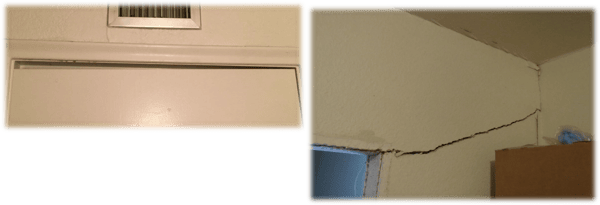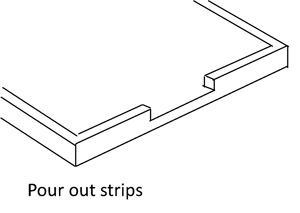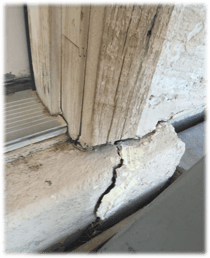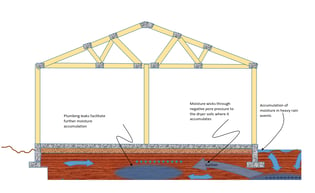When people call in to our office, it is typically because of signs of stress that they notice. It is important to remember that the signs of stress are less of a problem in and of themselves, but rather are clues to help us understand the type of movement and their meaning.
The first thing that we look at is the damage being on the perimeter walls (both on the interior of the wall and on the exterior of the wall), versus the inside walls. The outside walls are supported by footings and have the roof loads on them. Movement there most likely means settlement, since they are small, deeper and more heavily loaded, although on occasion it can heave there. Damage of interior walls that do not have footings or bear any roof loads, since they are up higher than footings, have a large contact area with the soil, and lightly loaded usually indicate heave. Again rarely on occasion, we have seen settlement in these areas.
Doors and windows out of square. (see below)

Interior doors out of square (pinched on one side, or a gap on the other) go along with interior walls. Exterior doors do not translate automatically in the same logic. The reason is that the pour out strips that go underneath the door frames.

These pour out strips (diagram to the left) are commonly done so that joints between the stem wall and interior floor slab does not run directly under the door threshold. You can see this easily by looking under the door and noticing a cold joint running down each side under the door frame.
When there is floor slab heave, you can see distress where this cold joint is as the stem wall does not move together with the floor slab.

 Most pour out strips don’t protrude like the one to the right. I have pictured it here because is easily illustrates the distress from the slab movement.
Most pour out strips don’t protrude like the one to the right. I have pictured it here because is easily illustrates the distress from the slab movement.
Since the door frame sits on top of the pour out strip and is part of the floor slab, an outside door that is out of square or pinched could equally be a result of footing movement or slab movement.
Windows out of square, on the other hand, almost always indicate footing movement since they rarely sit on top of the interior slab.
It’s worth noting that walls can be patched, and doors shaved off, but usually windows are not replaced for being out of square. As a result, windows are a more consistent sign of footing movement.
To summarize:
- Interior signs of stress in walls doors and windows usually signal interior floor heave
- Exterior signs of stress in walls doors and windows usually indicate footing settlement
- An important exception is exterior door frame movement that can equally signal footing settlement or floor slab heave.
- Windows are better indicators than other signs of stress than cracks in walls or doors out of square.
Next: Rules of Thumb IX: https://www.foundationaz.com/blog/rules-of-thumb-part-ix-signs-of-stress
Previous: Rules of Thumb VII: https://www.foundationaz.com/blog/rules-of-thumb-in-diagnosing-foundation-problems-part-vii-the-age-of-the-structure






